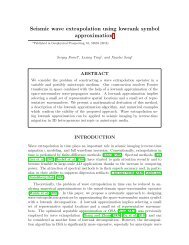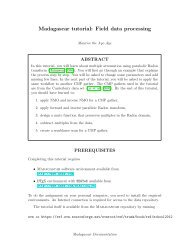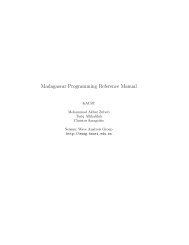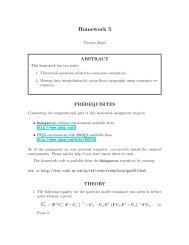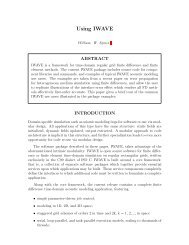Applications of plane-wave destruction filtersa
Applications of plane-wave destruction filtersa
Applications of plane-wave destruction filtersa
Create successful ePaper yourself
Turn your PDF publications into a flip-book with our unique Google optimized e-Paper software.
Fomel 18 Plane-<strong>wave</strong> destructors<br />
areas where only a single dip is present in the data. In other areas, it picks the complementary<br />
dip, which has a negative value for back-dipping hyperbolic diffractions.<br />
Figure 14 shows the interpolation result and the difference between the interpolated<br />
traces and the original traces, plotted at the same clip value. The method<br />
succeeded in the sense that it is impossible to distinguish interpolated traces from<br />
the interpolation result alone. However, it is not ideal, because some <strong>of</strong> the original<br />
energy is missing in the output. A close-up comparison between the original and the<br />
interpolated traces in Figure 15 shows that imperfection in more detail. Some <strong>of</strong> the<br />
steepest events in the middle <strong>of</strong> the section are poorly interpolated, and in some <strong>of</strong><br />
the other places, the second dip component is continued instead <strong>of</strong> the first one.<br />
One could improve the interpolation result considerably by including another dimension.<br />
To achieve a better result, we can use a pair <strong>of</strong> <strong>plane</strong>-<strong>wave</strong> destructors,<br />
one predicting local <strong>plane</strong> <strong>wave</strong>s in the <strong>of</strong>fset direction and the other predicting local<br />
<strong>plane</strong> <strong>wave</strong>s in the shot direction.<br />
Signal and noise separation<br />
Signal and noise separation and noise attenuation are yet another important application<br />
<strong>of</strong> <strong>plane</strong>-<strong>wave</strong> prediction filters. A random noise attention has been successfully<br />
addressed by Canales (1984), Gulunay (1986), Abma and Claerbout (1995), Soubaras<br />
(1995), and others. A more challenging problem <strong>of</strong> coherent noise attenuation has<br />
only recently joined the circle <strong>of</strong> the prediction technique applications (Spitz, 1999;<br />
Brown and Clapp, 2000; Guitton et al., 2001).<br />
The problem has a very clear interpretation in terms <strong>of</strong> the local dip components.<br />
If two components, s 1 and s 2 are estimated from the data, and we can interpret the<br />
first component as signal, and the second component as noise, then the signal and<br />
noise separation problem reduces to solving the least-squares system<br />
C(s 1 )d 1 ≈ 0 , (19)<br />
ɛC(s 2 )d 2 ≈ 0 (20)<br />
for the unknown signal and noise components d 1 and d 2 <strong>of</strong> the input data d:<br />
d 1 + d 2 = d. (21)<br />
The scalar parameter ɛ in equation (20) reflects the signal to noise ratio. We can<br />
combine equations (19-20) and (21) in the explicit system for the noise component<br />
d 2 :<br />
C(s 1 )d 2 ≈ C(s 1 )d , (22)<br />
ɛC(s 2 )d 2 ≈ 0 . (23)<br />
Figure 16 shows a simple example <strong>of</strong> the described approach. I estimated two dip<br />
components from the input synthetic data and separated the corresponding events by<br />
solving the least-squares system (22-23). The separation result is visually perfect.<br />
SEP–105




